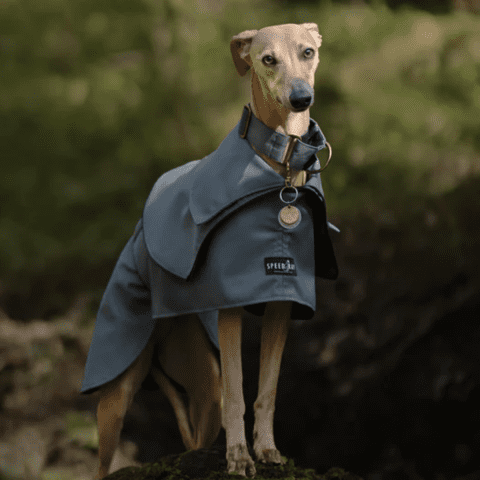As you explore the world of Greyhound breed dogs, you’ll notice that their impressive speed and agility can be attributed to three standout physical traits. You’re likely curious about what makes these dogs so incredibly fast, and it all starts with their body design. From their coat to their muscles, and even the shape of their head, every aspect of a Greyhound’s physical build has been optimized for speed and agility. But what exactly are these traits, and how do they work together to make Greyhounds the fastest dogs on four legs?
Aerodynamic Coat Design

As you gaze at a Greyhound, you can’t help but notice the sleek, smooth coat that appears to be tailored to reduce air resistance, making you wonder: is this aerodynamic design merely a coincidence, or did nature intentionally craft this breed for speed? The answer lies in the unique fur texture of the Greyhound. The short, fine hairs that cover their body are designed to reduce wind resistance, allowing them to cut through the air with ease. This specialized coat allows them to reach incredible speeds, making them the fastest dog breed on Earth. The fur’s smooth, glossy texture also helps to reduce air resistance, allowing the Greyhound to slice through the air with minimal drag. It’s no coincidence that nature has crafted this breed for speed, and their aerodynamic coat design is a key factor in their remarkable abilities. By examining the Greyhound’s coat, it’s clear that their body is a demonstration of the wonders of natural selection and adaptation.
Muscular Body Structure
You can’t help but notice the Greyhound’s athletic physique, which is characterized by a muscular body structure that’s optimized for speed and agility, with powerful legs, a flexible spine, and a deep chest that allows for maximum lung capacity. This racing physique is a reflection of the breed’s history as a sprinter, built for short, intense bursts of speed. The Greyhound’s athletic build is a result of centuries of selective breeding, where speed and agility were paramount. The breed’s muscular body structure enables it to accelerate rapidly, reaching speeds of up to 45 miles per hour. The deep chest and flexible spine work in tandem, allowing the Greyhound to take long strides and cover a lot of ground quickly. The powerful legs, with their well-defined muscles, provide the propulsion needed to achieve such incredible speeds. Overall, the Greyhound’s muscular body structure is a marvel of evolution, designed for speed, agility, and power.
Streamlined Head Shape
The Greyhound’s head, shaped like a narrow wedge, is precisely angled to reduce air resistance, allowing it to slice through the wind with minimal drag. This streamlined design enables Greyhounds to achieve incredible speeds, making them the fastest dog breed on Earth. As you gaze into a Greyhound’s face, you’ll notice its narrow muzzle, which is proportionate to the rest of its head. This unique feature allows for a more aerodynamic shape, further enhancing its speed capabilities. The facial expression of a Greyhound is often described as gentle and calm, which complements its athletic build. The head’s shape also allows for a wider field of vision, giving Greyhounds exceptional peripheral vision. This, combined with their incredible speed, makes them expert hunters and racers. As you observe a Greyhound’s head, you’ll appreciate the intricate balance of form and function that has evolved to make them the ultimate speedsters.
Frequently Asked Questions
Do Greyhounds Make Good Family Pets?
As you consider bringing a greyhound into your family, remember they thrive in harmonious households with established pet hierarchies, making them a great fit for families with gentle, respectful dynamics.
Are Greyhounds Prone to Specific Health Problems?
You’ll want to know that 70% of Greyhounds die from cancer, emphasizing the importance of monitoring their health. As a Greyhound owner, you should be aware of genetic predispositions, such as bloat, osteosarcoma, and common ailments like heart issues and musculoskeletal problems.
How Often Do Greyhounds Need to Be Exercised?
As you welcome a greyhound into your life, you’ll need to provide regular exercise, ideally 2-3 times a week, with short, gentle morning jogs and occasional longer running routes to keep them happy and healthy.
Can Greyhounds Adapt to Living in Small Spaces?
Coincidentally, you’re wondering if greyhounds can adapt to small spaces, and you’re not alone! Many urban dwellers face space constraints, but greyhounds, surprisingly, can thrive in apartments with regular exercise and attention, making them a great fit for urban living.
Are Greyhounds Easy to Train?
You’ll find greyhounds are relatively easy to train, responding well to positive reinforcement command styles and consistent training methods, making them a great breed for first-time dog owners or those short on time.
Conclusion
You’ve witnessed the awe-inspiring physical traits that make Greyhounds the ultimate speed demons! Their aerodynamic coat design slices through the air like a hot knife through butter, their muscular body structure propels them forward like a rocket, and their streamlined head shape lets them see it all without a hint of wind resistance. It’s no wonder they’re the fastest dogs on four legs – they’re basically biological rockets!
